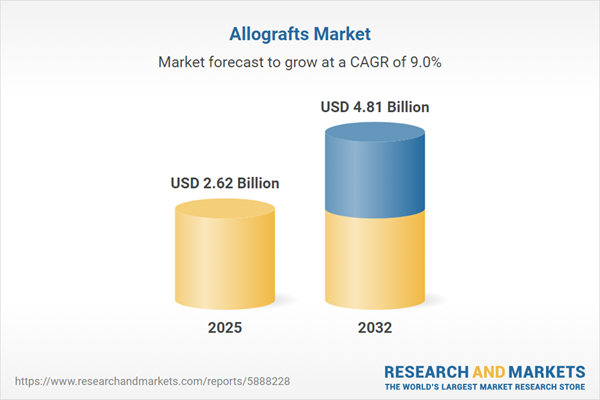Speak directly to the analyst to clarify any post sales queries you may have.
The allografts market demonstrates significant momentum, driven by technological innovation, evolving clinical practice, and regulatory alignment across key healthcare sectors. Senior decision-makers require a clear view of product segmentation, regional outlook, and competitive strategies to identify scalable opportunities in this rapidly advancing landscape.
Allografts Market Snapshot
The allografts market grew from USD 2.40 billion in 2024 to USD 2.62 billion in 2025. It is projected to expand at a CAGR of 9.04%, targeting a total value of USD 4.81 billion by 2032. Demand is increasing across segments as healthcare providers seek biological scaffolds that optimize integration, safety, and efficiency. Ongoing advances in graft processing and preservation, combined with agile supply chain models, support this steady upward trend for all key end-users.
Scope & Segmentation of the Allografts Market
This report delivers comprehensive segmentation covering applications, technologies, and geographies:
- Product Type: Cancellous bone (bone blocks, bone chips), cortical bone (blocks, chips, strips), demineralized bone matrix (gel, putty, sheet)
- Application: Dental, orthopedic, plastic surgery, spinal fusion, sports medicine
- End User: Ambulatory surgical centers, clinics, hospitals
- Processing: Cryopreserved, decellularized, fresh frozen, sterilized
- Source: Animal (bovine, porcine), human cadaveric
- Geographies: Americas (North America, Latin America), Europe, Middle East & Africa, Asia-Pacific
- Key Companies Assessed: Stryker Corporation, Zimmer Biomet Holdings, Inc., Integra LifeSciences Holdings Corporation, MiMedx Group, Inc., Organogenesis Inc., RTI Surgical, Inc., LifeNet Health, AlloSource, MTF Biologics, Tutogen Medical GmbH
Segment tracking evaluates clinical outcomes, processing technology adoption, and regulatory requirements within distinct global regions—identifying both mature and emerging markets for tailored strategy development.
Key Takeaways: Strategic Insights Shaping Allografts
- Preservation and decellularization innovations have increased graft viability, driving broader indications and surgical acceptance.
- Regulatory evolution and harmonized frameworks heighten market access, while prompting compliance with quality and safety standards.
- Interdisciplinary partnerships between manufacturers, clinicians, and academic research fuel R&D investments, resulting in differentiated product portfolios and accelerated knowledge transfer.
- Shifting reimbursement models require agile responses from both payers and providers, leading to strategic alliances and inventory optimization initiatives.
- Emerging economies, particularly in Asia-Pacific and parts of EMEA, represent robust growth areas amid rising healthcare investment and demand for minimally invasive procedures.
- Advanced analytics and digital health enable stakeholders to match inventory with market demand, reducing bottlenecks and enhancing just-in-time delivery capabilities.
Impact of United States Tariffs on Allografts
Recent tariffs enacted in 2025 have altered trade flows, influencing pricing structures and procurement strategies within the United States and globally. Organizations have responded by diversifying manufacturing bases, renegotiating supply chains, and shifting to regional sourcing solutions to minimize exposure. Healthcare providers must now balance procedural cost with graft performance, emphasizing supply chain flexibility and risk mitigation moving forward.
Research Methodology & Data Sources
The allografts market analysis is constructed from direct primary interviews with clinicians and procurement leaders, enhanced by secondary review of peer-reviewed literature, regulatory sources, and industry white papers. Quantitative analysis and data triangulation secure reliability and ensure the findings reflect the most current market dynamics and clinical practices.
Why This Report Matters for Senior Decision-Makers
- Unmatched depth on segmentation, regional drivers, and company strategies equips leaders to make informed investment, sourcing, and R&D decisions.
- Actionable recommendations facilitate operational resilience and opportunity capture across diverse healthcare settings.
- Insight into clinical adoption trends, evolving supplier partnerships, and regulatory shifts enables proactive planning and risk reduction.
Conclusion: Strategic Outlook for the Allografts Market
Innovation, regulatory alignment, and data-driven adaptation continue to define the allografts market. Stakeholders who prioritize flexibility, robust partnerships, and clinical insight will be best positioned for sustained growth and competitiveness in the evolving healthcare environment.
Additional Product Information:
- Purchase of this report includes 1 year online access with quarterly updates.
- This report can be updated on request. Please contact our Customer Experience team using the Ask a Question widget on our website.
Table of Contents
3. Executive Summary
4. Market Overview
7. Cumulative Impact of Artificial Intelligence 2025
Companies Mentioned
The companies profiled in this Allografts market report include:- Stryker Corporation
- Zimmer Biomet Holdings, Inc.
- Integra LifeSciences Holdings Corporation
- MiMedx Group, Inc.
- Organogenesis Inc.
- RTI Surgical, Inc.
- LifeNet Health
- AlloSource
- MTF Biologics
- Tutogen Medical GmbH
Table Information
| Report Attribute | Details |
|---|---|
| No. of Pages | 186 |
| Published | October 2025 |
| Forecast Period | 2025 - 2032 |
| Estimated Market Value ( USD | $ 2.62 Billion |
| Forecasted Market Value ( USD | $ 4.81 Billion |
| Compound Annual Growth Rate | 9.0% |
| Regions Covered | Global |
| No. of Companies Mentioned | 11 |









